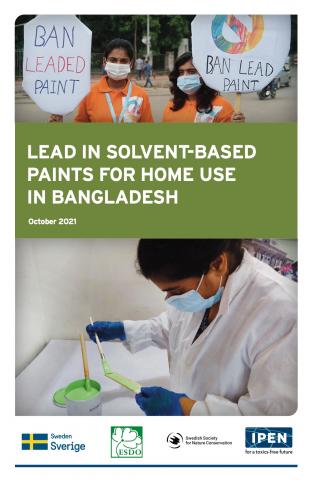Lead in Solvent-based Paints for Home Use in Bangladesh

Most highly industrial countries adopted laws or regulations to control the lead content of decorative paints—the paints used on the interiors and exteriors of homes, schools, and other child-occupied facilities—beginning in the 1970s and 1980s. In Bangladesh, ESDO has been working with key government agencies since 2010 to establish a specific regulation on lead in paint. ESDO has prepared a draft regulatory framework and guideline, and submitted it to the Department of Environment (DOE). As a result, the Bangladesh Standard and Testing Institute (BSTI) in 2018 has finalized a standard for the paint manufacturing industry, setting a maximum limit of harmful lead content at 90 parts per million (ppm) for household paints including enamel paints, synthetic paints, exterior paints for undercoating and finishing, and emulsion paints.
From February to April 2021, ESDO purchased a total of 63 cans of solvent-based paint sold for home use from stores in Dhaka, Bangladesh. The paints represented 26 different brands produced by 21 manufacturers. All collected sample paints were analyzed by an accredited laboratory in the United States of America for their lead content, based on dry weight of the paint. The laboratory has also participated in the Environmental Lead Proficiency Analytical Testing (ELPAT) program operated by the American Industrial Hygiene Association (AIHA), assuring the reliability of the analytical results.
Twenty out of 63 analyzed solvent-based paints for home use (32 percent of paints) were lead paints, i.e., they contained lead concentrations above 90 parts per million (ppm, dry weight of paint). This is also the regulatory limit for lead in decorative paint in e.g., India, the Philippines, and the United States of America. Moreover, six paints (10 percent of paints) contained extremely high lead concentrations above 10,000 ppm. The highest lead concentrations detected were 190,000 ppm in a yellow industrial paint and 52,000 ppm in a yellow decorative paint sold for home use. Both paints were manufactured in Bangladesh.
On the other hand, 43 out of 63 solvent-based paints for home use (68 percent of paints) contained lead concentrations below 90 ppm, suggesting that the technology to produce paint without leaded ingredients exists in Bangladesh.
Twelve out of 26 analyzed brands (46 percent of paint brands) sold at least one lead paint, i.e., a paint with lead concentration above 90 ppm. Six out of 26 analyzed brands (23 percent of paint brands) sold at least one lead paint with extremely high lead concentrations above 10,000 ppm.
This study shows that yellow paints most frequently contained extremely high lead concentrations above 10,000 ppm. In fact, all six paints which contained lead levels above 10,000 ppm were yellow paints (43 percent of yellow paints).
| Attachment | Size |
|---|---|
| 4.27 MB |
